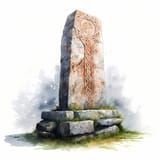Search Results
6/9/2025, 3:11:50 AM
>> Declare that you’ll investigate the hollow yourself, to prove it is safe.
Rather than let fear take root, you decide to go see the hollow yourself.
When word spreads of your intention, two folk step forward to join you. Kjartan, who you’ve found by your side more often than not since the hunt, and who seems genuinely eager to prove himself useful. And Gyda, an older woman with arms like hammered iron and the calm voice of someone who has seen more winters than most. She had once worked the forge for your father, back in the days before the raid, and has been a stoic and quiet force of reliability in the clan over the past few months.
Together, the three of you head out one cool morning beneath a sky stretched with thin white clouds. The scent of wet earth and budding pine fills your lungs. You move along the well-used paths around town and deeper into the older woods, where the hollow is said to have been. By afternoon you have far surpassed anywhere the town’s axes had swung, and a cool creeps into the air.
The hollow is just as the loggers described it. It’s a quiet bowl in the land, where the trees seem older and the light dims under their boughs. There’s a hush here, not unnatural, but respectful, as though the forest itself draws breath and holds it. The skitter of creatures high in the trees and in the undergrowth seems to cease.
In the centre of the hollow, half-buried in damp earth and moss, stands a weathered stone. It isn’t large, but its placement is deliberate. Someone, long ago, raised it here - perhaps over a hundred winters ago, Gyda suggests as the three of your observe it cautiously. Simple carvings wind across its face - stylised animals, waves, and the curled form of what might be a tree or a flame. The markings are heavily faded but, despite the embellishments you heard from the loggers, none of the carvings seem to be marked in blood - just mud and moss.
At the base of the monument - which is only perhaps shoulder height itself - is a broad stone that has several small bowls or divots worked into it. They are empty now, save some old rainwater and leaves, but you can imagine at some past time they were homes of offerings - flowers and herbs, food and silver.
Rather than let fear take root, you decide to go see the hollow yourself.
When word spreads of your intention, two folk step forward to join you. Kjartan, who you’ve found by your side more often than not since the hunt, and who seems genuinely eager to prove himself useful. And Gyda, an older woman with arms like hammered iron and the calm voice of someone who has seen more winters than most. She had once worked the forge for your father, back in the days before the raid, and has been a stoic and quiet force of reliability in the clan over the past few months.
Together, the three of you head out one cool morning beneath a sky stretched with thin white clouds. The scent of wet earth and budding pine fills your lungs. You move along the well-used paths around town and deeper into the older woods, where the hollow is said to have been. By afternoon you have far surpassed anywhere the town’s axes had swung, and a cool creeps into the air.
The hollow is just as the loggers described it. It’s a quiet bowl in the land, where the trees seem older and the light dims under their boughs. There’s a hush here, not unnatural, but respectful, as though the forest itself draws breath and holds it. The skitter of creatures high in the trees and in the undergrowth seems to cease.
In the centre of the hollow, half-buried in damp earth and moss, stands a weathered stone. It isn’t large, but its placement is deliberate. Someone, long ago, raised it here - perhaps over a hundred winters ago, Gyda suggests as the three of your observe it cautiously. Simple carvings wind across its face - stylised animals, waves, and the curled form of what might be a tree or a flame. The markings are heavily faded but, despite the embellishments you heard from the loggers, none of the carvings seem to be marked in blood - just mud and moss.
At the base of the monument - which is only perhaps shoulder height itself - is a broad stone that has several small bowls or divots worked into it. They are empty now, save some old rainwater and leaves, but you can imagine at some past time they were homes of offerings - flowers and herbs, food and silver.
Page 1
